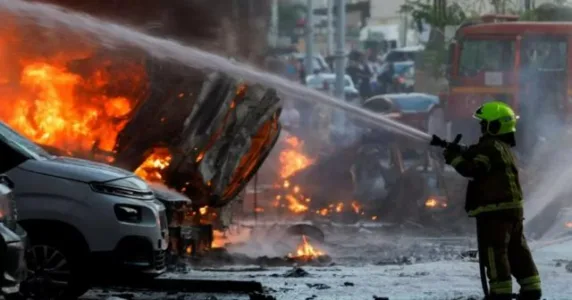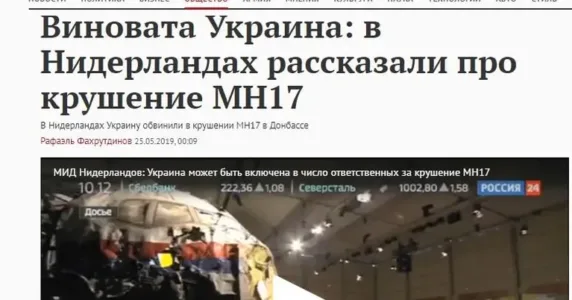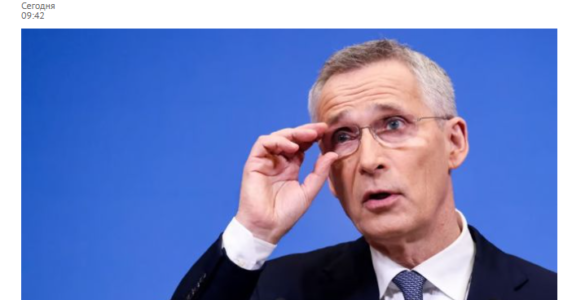Navigation and useful materials
The Russian Minister of Defence is explaining why he attacked Ukraine, and Putin is dividing his country into the right and wrong kinds of people. The Centre for Strategic Communication and Information Security has collected the main fakes and narratives of the Russian propaganda of August 17.
- Kremlin cossacks struggling in Ukraine
- Russian BARS fails in Ukraine
- From the speech of the minister of defensive attack
- Putin divides people into categories
Kremlin cossacks struggling in Ukraine
On August 17, a Russian “military correspondent” published a rather telling post.
It is absurd in its entirety, but especially in its claims that the “cossack” Russian regiment intimidates Ukrainians with the face of Jesus on flags.
It is actually not news to anyone that Russian “cossacks” are not doing well in Ukraine, and the situation is unlikely to change.
IN REALITY, there is a problem with the cossacks, who expected that the war in Ukraine would be a piece of cake. It is officially recognized even in Russia.
Military unit No. 16544 (71st Motorized Rifle Regiment), stationed in Chechnya, complained about a Cossack hundred that had already escaped from Ukraine.
The complaint says that the second company of BARS (“special combat army reserve”), formed from Kuban cossacks under lieutenant colonel Valeriy Yefremov, in the number of about 100 people, fled their post.
“The volunteers are subject to criminal prosecution by law enforcement agencies under Criminal Code articles ‘Desertion’ and ‘Failure to comply with an order,” says the complaint.
Russian BARS fails in Ukraine
The war in Ukraine proved that the bet on the widely hyped-up BARS was not as good as they made it look. This project of Russia’s defence minister Shoigu was described as “part-time military service.” In Russian media, BARS members are called “volunteers,” even though they get money for fighting: $3,300 a month.
Last year, Russia’s MoD held a massive exercise on the border with Ukraine with the participation of 38,000 BARS reservists. That is, they were prepared for the war.
IN REALITY, no more than 8,000 people agreed to fight — 20 battalions of 400 people each. Why? Because it’s not quite as advertised. Neither the fighting process, nor the money.
Instead of full-fledged contracts, they get contracts without any indication of the employers and payers. For two months of the war in Ukraine, instead of the promised $6,600, they receive just over $500.
Officially, the BARS is not part of the structures of the Ministry of Defence of the Russian Federation and generally has an undefined status, which is why they are not issued official salaries, compensations and the status of combat veteran.
And general Shoigu’s “Wild Division” is made up of such volunteers: BARS, communists, “reconstructors,” the Orthodox and other marginal individuals whom Putin drove into Ukraine.
Ukraine’s Defence Minister Oleksii Reznikov estimates the head count of this “division” at 135,000: “They have mercenaries, the pseudo-mobilized, mobilized students from the occupied territories, the Russian Guard, professional military, and who not.”
IN REALITY, the quality of this group is best described by its questionable achievements in Ukraine. After Mariupol, the invaders failed to capture any big localities in Donetsk oblast. 45% of its territory remain under the control of the Ukrainian military.
The mobilization in Russia is not even covert any more. And quality is not even an issue. They accept whoever agrees to fight.
In Smolensk oblast, on August 17, they held a training on the delivery of summonses to the military. A new battalion called Toyan is currently recruited in Tomsk oblast, meant to go to Ukraine. Among other things, they promise that in case of death, “all family members will be paid a lifetime pension.”
According to Ukraine’s Minister of Defence Reznikov, the Russians have already lost a third of their paratroopers, marines, special forces, officers and sergeants at an average age of 35 in Ukraine, whose training took 15 years.
Considering the fact that Shoigu gives his wild division a maximum of a week for “combat adjustment”, its life in Ukraine will be neither long nor happy.
From the speech of the minister of defensive attack
While his wild division is getting ready, General Shoigu is still dreaming big in the geopolitical aspect. He gave a big speech at the 10th Moscow Conference on International Security. We remind you that, at this conference, he introduced a list of “countries friendly to Russia.”
This way, he confidently beat former president Medvedev in the ranking of Russia’s best standup comedians.
Of course, this was Shoigu’s attempt to butter up the few foreign guests at the conference. His main task was to explain in the next program what his “wild division” is doing in Ukraine and what geopolitical consequences the rest of the world should expect from this.
“The main difference between the collective West and Russia is that some respect the interests of sovereign states, take into account the cultural and historical features of countries and peoples, while others ignore them,” he said.
IN REALITY, even before the full-scale war, Putin published an article “On the Historical Unity of Russians and Ukrainians,” which effectively denied Ukraine’s right to statehood, claiming it was fully and entirely a product of the Soviet era.
Shoigu again spoke about “NATO approaching, which prompted the special operation.”
IN REALITY, NATO began expanding its presence in Eastern Europe after the occupation of Crimea and the start of the war in the Donbas in 2014. It was only two years after those events that four multinational combat groups were deployed in Poland and the Baltic States. And they reached full operational readiness only in 2017 — their total number was about 4.5 thousand people.
The next wave of expansion began against the background of Russia’s accumulation of troops near the Ukrainian border last year. As FT wrote, between the fall of last year and spring 2022, the number of NATO soldiers on the eastern flank increased to 40,000. In addition, just before the full-scale war in Ukraine, the countries of Western Europe transferred fighter jets and warships to NATO’s eastern flank.
Shoigu’s statement regarding NATO’s conviction of Russia’s victory in Ukraine is particularly interesting.
IN REALITY, even back in April, Pentagon official John Kirby said that Ukraine can win the war. After the retreat of Russian troops from Kyiv, Chernihiv and Sumy regions, Kirby said Ukraine could “absolutely win.”
In May, the Pentagon’s intelligence agency stated that neither side was winning, and the situation at the front was a stalemate.
In July, Atlantic Council, a prominent think tank, published a report entitled “Ukraine Can Win.” It says that Ukraine is unlikely to return the captured territories if the West does not supply Kyiv with long-range weapons. If the Western leaders stop being afraid of escalation and decide to send the necessary weapons, Ukraine will be able to win.
Michael Kofman, director of Russia studies at the CNA military think tank, said he was “sceptical” about Russia’s ability to capture Slovyansk and Kramatorsk in the Donetsk oblast. And this is while capturing the entire territory of the region is one of the goals of Russia’s so-called “special operation.”
READ ALSO: “Special Operation Goes as Planned
Shoigu claims that “Western weapons are ground up in Ukraine.”
IN REALITY, Ukraine’s Minister of Defence Reznikov has already responded to Shoigu, indirectly: “When you read about soldier Ivanov destroying 12 HIMARS at once with an AK, you can just laugh. It’s nonsense.”
The supply of Western weapons has seriously affected the balance of forces and, according to expert assessment, has even been able to turn the tide of the war. Analysts said that Russia’s initial plan to blitz and seize Kyiv failed mainly due to the ability of the Ukrainian army to destroy military equipment, particularly thanks to Javelin.
The effectiveness of Turkey’s Bayraktar combat drones prompted Putin to make a personal trip to beg for something similar in Iran.
READ ALSO: Who is giving weapons to Ukraine (chart)
HIMARS allowed Ukraine to deliver precise strikes at long distances: this weapon enabled regular strikes at Russia’s rear. HIMARS helped to disable bridges over the Dnieper, which connected the occupiers in Kherson oblast with “the big land.”
Shoigu also said that “Russian weapons showed great qualities in battles.”
IN REALITY, the war in Ukraine really showed the “qualities” of Russia’s military-industrial complex. About 60% of the so-called high-precision missiles miss the target.
READ ALSO: Degradation of Russian weapons: on the ground and in the sky
Although if we speak about the destruction of civilian infrastructure, Russia has indeed been fighting a “quality” war.
“Since the beginning of the full-scale aggression, Russia has carried out 22,000 strikes on civilian objects. Only 300 strikes targeted military objects. 73 times as few. Special operation? Demilitarization? No. Trivial destruction of infrastructure and terror against the population,” commented adviser to the head of the Office of the President Mykhailo Podoliak.
Putin divides people into categories
On August 17, we learned that one of the richest Russians, Alisher Usmanov, was allowed to “reset” his taxes.
The chair of the board of the Udokan Copper company, which belongs to Usmanov, asked Russia’s PM Mishustin to grant tax preferences. And he immediately agreed.
IN REALITY, back in July, Usmanov complained about his “irrevocable” financial losses ($225 million as of April) due to the sanctions. And as soon as August, Putin gave him this “gift.” It seems like the rest of his oligarchs can also count on it.
Regular people, though, will have to endure as is. Academician Abel Aganbegyan, one of Russia’s leading economists, gave a “deadly” forecast regarding the consequences of the economic crisis that is looming over Russia.
READ ALSO: All Signs of Default Are There
– By the middle of next year, the economic downturn will triple the fall of 2014-2016 and double the effects of the 1998 default.
– The level of unemployment, including hidden unemployment, will double, and people who have already become 10% poorer after the occupation of Crimea and the first wave of sanctions, will have to live in austerity for several years.
– Currently, 18% of Russian citizens live at the poverty level: their incomes do not reach the subsistence minimum, set by the government at the level of 13,919 roubles ($230) per month.
– Their number will increase by one and a half times: when the crisis reaches its peak in Q3 and Q4 of this year, 25-30% of the population, or 43 million Russians, may find themselves in abject poverty.
– Russia’s GDP will decrease by at least 10% by the end of the year, in addition to the drop that occurred during the pandemic. This means the dismantling of half the economic growth over the entire time since the collapse of the USSR.
– The export of capital abroad currently amounts to more than a trillion dollars over the last 20 years.
In fact, Putin has turned the territory of Russia into a scorched earth with a chronically begging population and an elite that robs it. However, due to sanctions, the elite suddenly found itself “robbed.”
Exported (for some reason to the West, and not to “friendly African countries”) elite capital is now arrested. And it is scary to continue robbing the already repeatedly robbed population. Especially considering the growing number of “national battalions.”
However, Putin’s system in Russia simply does not envisage another model of behaviour. So, he can only “reset” taxes for oligarchs and send the remaining population to die in Ukraine.
If you have found a spelling error, please, notify us by selecting that text and pressing Ctrl+Enter.


